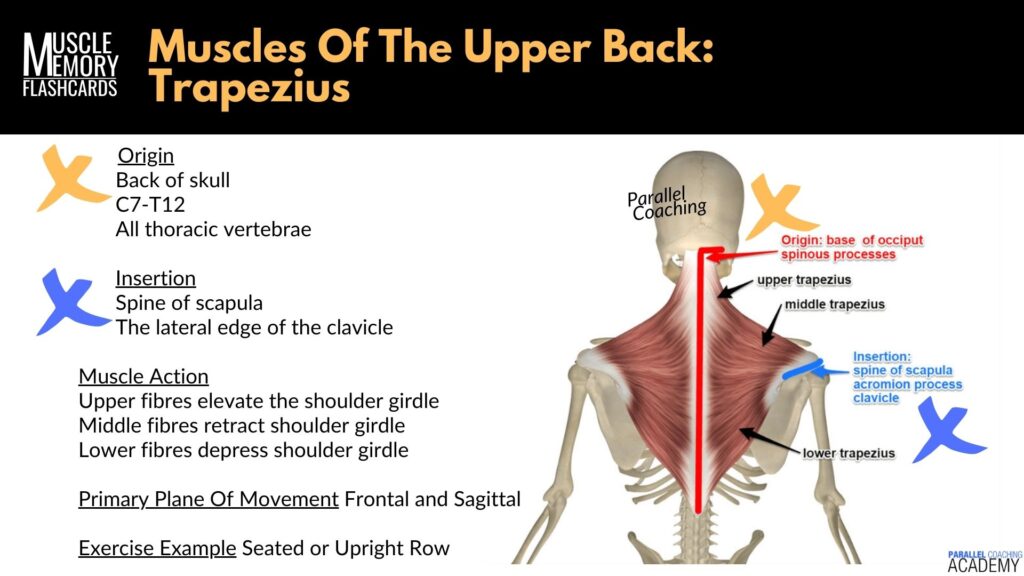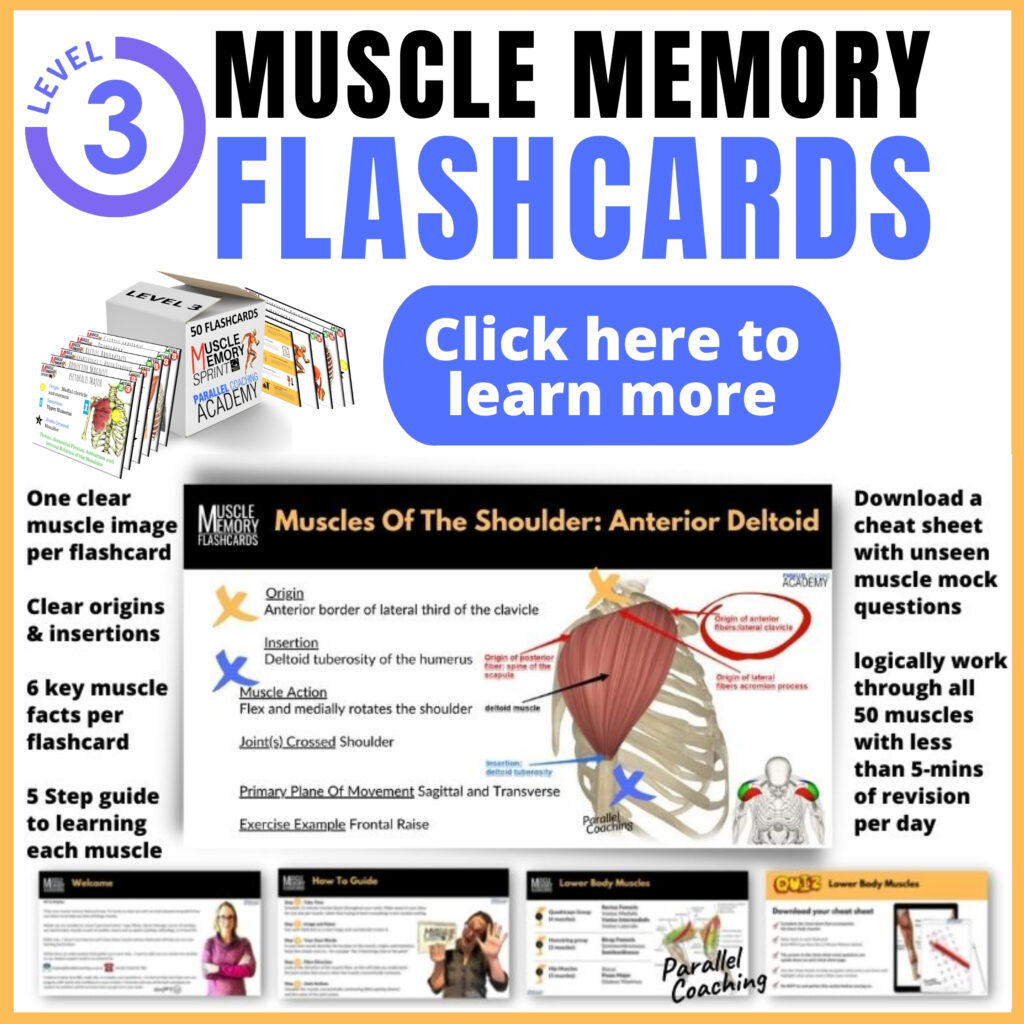In today’s video training, you’ll learn how to remember muscle origin and insertion of the Trapezius ready for your Level 2 or Level 3 Anatomy and Physiology Exam
I’ll show you exactly how to remember complex information about the Trapezius, including the origin and insertion, location, muscle action, and exercises that work the muscle. This means that you use a mix of visual and kinaesthetic learning to commit the facts to your memory and forge out a new neural pathway.
You can then use this same method of learning for all of the other muscles you need to learn for your Level 2 and Level 3 anatomy and physiology exam.
First of all, watch the 11-minute video tutorial and then test your knowledge using the three mock questions at the bottom of this blog.
Watch: Origin and Insertion of The Trapezius
Where is the Trapezius?
The trapezius is a large diamond shape muscle at the back of the body.
It is made up of a triangle on the left-hand side and a triangle on the right-hand side
You need to know key information about The Trapezus for your exam including the location, Origin and insertion, muscle action, and example exercises.
What is the Origin and Insertion of The Trapezius?
Origin: Base of the Skull and C7-T12 Thoracic vertebrae
Insertion: Spine of Scapula and Lateral Clavicle
What is the Muscle Action of the Trapezius?
The Trapezus crosses the Shoulder girdle, but not the ball and socket shoulder joint. Therefore the joint actions of the Trapezius are concerned with the movement of the shoulder girdle not the arm/ shoulder.
The shoulder girdle is made up of the scapula and clavicle.
When you look at the Trapezius muscle, you will see the line of fibre is varying, fanning out from the origin towards multiple insertion points.
This indicates the direction of the muscle contraction. When the muscle concentrically contracts the muscle fibres get shorter, bringing the insertion towards the origin.
Therefore there are three muscle actions that are possible at the Trapezius:
Upper Fibres = Elevation of the shoulder girdle
Mid Fibres = Retraction of the Shoulder Girdle
Lower Fibres = Depression of the Shoulder Girdle
Exercises that work the Trapezius include:
- Seated Row
- Resistance band Row
- Bent-Over Row
- Upright Row
- Rear (Prone) Fly
In this video we follow 5 simple steps to help you To Remember Muscle Origins and Insertions
This 5 step strategy will simplify and structure how you are learning the key muscle information. This is not only great for your exam, but also when planning and working with clients.
Step 1: Take Time
Schedule 15-minute chunks spread throughout your week. Make space in your diary for one slot per muscle, rather than trying to learn everything in one revision setting.
Step 2: Image and Name
Use a clear image, like those in our L2/3 Flashcards, of the muscle you are learning. Ensure the name is clearly printed on the image to make it easy to commit to your visual memory.
Look at the image and close your eyes to see if you can remember the image and name together.
Here’s an example of the Trapezius from our Muscle Memory Sprint Flashcards:
Yes – let me see the L2 Flashcards or L3 Flashcards

Step 3: Your Own Words
In your own words describe the location of the muscle and Origins and Insertions.
So for Trapezius, I might say
“its my upper back. It orignates on the base of skull and spine down to end of rib cage”
Then double-check the “official” terminology of the origin and insertion so you know for sure.
Step 4: Fibre Direction
Look at the direction of the muscle fibre, as this will help you understand the joint action that occurs when the muscle concentrically contracts.
So as the muscle shortens you can imagine the insertion being drawn closer to the origin.
Step 5: Joint Actions
Visualize the muscle concentrically contracting (fibres getting shorter) and the name of the joint action.
In my example, this would be Scapula Retraction, Elevation and Depression
Then pick an exercise that works this muscle. For example, To target the Trapezius I could choose the Seated Row machine.
By repeatedly doing this exercise you can feel the muscle contracting and relaxing, which helps you to commit it to memory.
Test your knowledge with 3 Mock Questions
Look at the Muscle Anatomy and Physiology Mock questions below and jot down your answer on scrap paper or as a note in your phone.
Then scroll down to reveal the answers.
1) What action occurs when the mid fibres of the trapezius concentrically contract?
A. Elevation of the scapula
B. Retraction of the scapula
C. Flexion of the shoulder
D. Lateral flexion of the spine
2) What is the insertion of the trapezius muscle?
A. Base of skull and C7 to T12
B. Base of skull and spine of scapula
C. Spine of scapula and lateral clavicle
D. Spine of scapula and humerus
3) Which exercise does NOT work the Trapezius muscle?
A. Seated Row
B. Lateral Raise
C. Upright Row
D. Bent Over Row
Answers:
Q1: Answer = B
Q2: Answer = C
Q3: Answer = B
If you want more mock questions like this, then you can download more Free Mock Questions: DOWNLOAD NOW
How to learn orgins and insertions?
Learn, Revise & Remember All 50 Muscles In The Level 3 Anatomy & Physiology Exam.
(and the BEST part…You can do all this in as little as 5-minutes a day)
Each flashcard gives you a clear image and six clear muscle facts:
- Name and Location
- Origin and Insertions
- Muscle Actions
- Joints Crossed
- Primary Planes Of Movement
- Exercise Examples

Dedicated to More
Hayley “Origins and Insertions of the Trapezius” Bergman
Parallel Coaching
P.S. You can also find us on the following platforms:
Instagram: Follow Now
Facebook: Like Our Page
Twitter: Tweet Us
YouTube: Subscribe Here
More Circulatory System Blogs: HERE
More Muscle Revision Blogs: HERE

